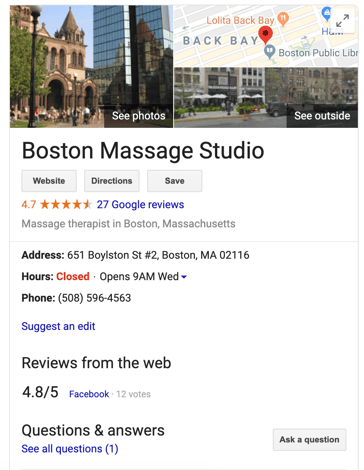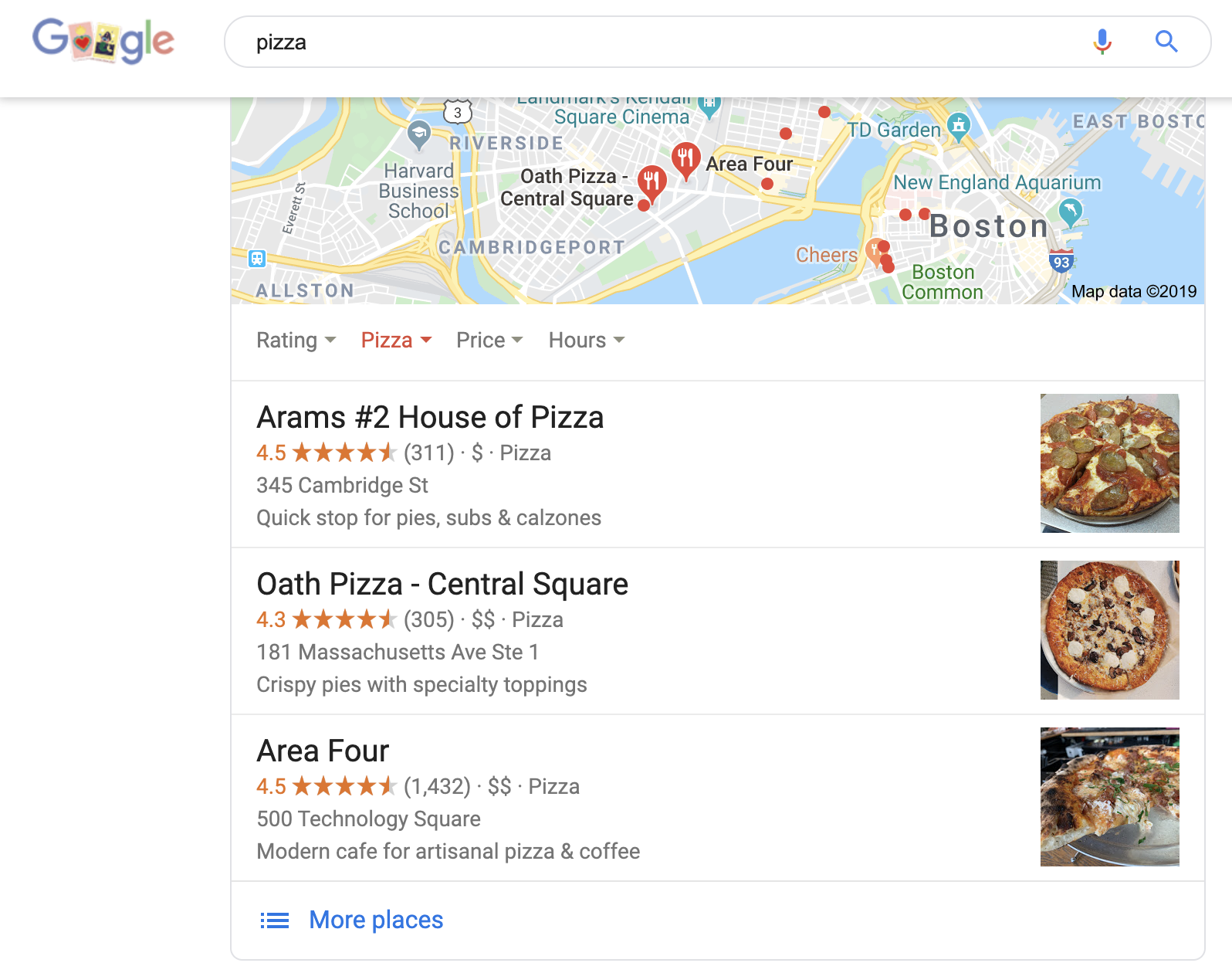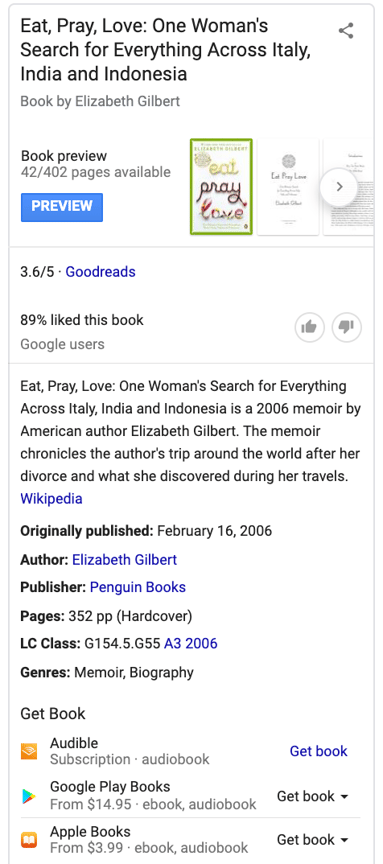The era of the high Google click-through rate is nearing its end and the age of the low-click landscape is dawning.
While Google is still the number one traffic source for most sites on the web, over half of all searches these days result in no click at all.
There are a multitude of reasons to explain this shift. More searchers are finding the information they need from featured snippets, which have increased in prevalence tremendously in recent years.
SERP features — including rich snippets, paid ads, and Knowledge Graph data — have overtaken the results pages, making at-a-glance answers the norm.
Additionally, increasingly robust Google My Business profiles provide more information than ever before, allowing people to find business hours, book appointments/rooms/flights, and read reviews in the SERPs themselves (in addition to much, much more) without ever needing to visit a website.
These developments are great for the searcher experience, but they spell trouble for your clients' site traffic.
What's a marketer to do? It's frustrating when so much of your reporting and success metrics are tied up in the very details that are becoming rarer and rarer as Google redefines what it means to search. You're invested in keeping both clients and stakeholders happy if you'd like to keep your job, and what keeps them happy are high revenue numbers and graphs that move up, and to the right.
But don't get discouraged — the new low-click landscape of search may feel unfamiliar, but there's more potential there than you might think. Let's dive into three big ways fewer clicks from the SERP to your site can actually be a good thing.
How to Optimize for Higher On-SERP Conversions
A "conversion" isn't the same for everyone — it's all in how you define it. A conversion for a SaaS company might be the act of purchasing a software subscription, while a conversion for a local business might be as simple as a searcher calling their business.
The kinds of conversions you'll see happening directly on the SERPs depends largely on the types of clients you serve.
Next, let's explore how you can optimize for on-SERP conversions.
1. Local businesses and brands can meet the needs of specific locations.
Google has devoted a huge amount of effort into improving the local search experience for consumers.
Local search results are filled to the brim with special features beyond organic links to a website, with Google My Business (GMB) profiles and "local packs" being two of the most prominent things a local searcher encounters.
For instance, when searching for a "nearby massage studio", you might come across a Google My Business profile like this one, which includes information on a company's hours of operation, phone number, address, and even reviews from the web.

Again, depending on what a conversion means to you and your clients, both local packs and GMB profiles provide ample opportunity for them.
Local packs, shown in the example below, even offer a short list of options based on the business' proximity to the searcher; upon clicking for more info, you're given the option to head to the website, find map directions, click-to-call, and sometimes even place an order through a third-party service. That's right — for local businesses, there's an ad-free option to sell your products or services directly in the SERPs.

Nobody needs to visit your client's website to find its hours of operation, contact information, or FAQ. Instead, it's all laid out for them on Google as soon as they hit "enter." In a very real sense, a local client's Google My Business profile is their new homepage.
There are a multitude of ways marketers can optimize for in-SERP conversions for their local clients:
- Build out accurate listing information for each discrete location to ensure foot traffic driven from search gets to the right place (also a type of conversion!)
- Use Google Posts to promote sales, events, news, products, and special offers to entice both foot traffic and the now-elusive site click. Make sure you have an enticing image that includes a CTA button
- Reduce friction and create an in-SERP FAQ by answering Google Q&A in GMB profiles
- Seed common industry questions and answers in the Business Questions section
- Add UTM tracking to Google My Business profile CTAs to help you accurately report your successes to clients and stakeholders
Only about 22% of businesses are satisfied with their conversion rates. That means you've got a huge amount of opportunity to wow your local clients by boosting their numbers through creative, strategic use of the local SERPs.
2. National and digital brands can harness the power of the low-click landscape.
In-SERP conversions aren't restricted to your local clients alone. There are several ways certain national and digital-only brands can harness the power of the low-click landscape to make money and generate leads.
- In-SERP bookings: The travel and hospitality industries have a huge amount of potential for conversions directly in the SERP results, with the ability to book a hotel room or a flight often appearing directly below the query.
- Media purchases: Movies, albums, and books often appear with options to buy directly via various platforms on the SERPs. These look quite a lot like Knowledge Panel results, but they absolutely drive conversions for your media clients.
For instance, take a look at the options for immediate, in-SERP purchasing when you search for the book Eat, Pray, Love:

Searchers for the book can get the book as an ebook or audiobook straight from the SERP page.
Additionally, it's important to note — in the past, looking up song lyrics would go to Google Play and drive purchases there, but the search engine has pulled back on that recently (possibly due to backlash from lyrics sites).
Suffice to say, it's worth it to keep an eye out for any experiments or changes Google might make that would represent a conversion opportunity.
3. Businesses can build brand awareness with on-page SERP features.
This section is going to scare some of you, and I don't blame you. But consider for just a moment: maybe traffic isn't the end-all be-all to search.
Traffic is easy to measure and looks nice in reports, but it doesn't tell the whole story of your client's brand. Traffic is a symptom, not a cause.
Your efforts to show up on page one shouldn't eclipse the fact that, at the end of the day, Google likes to rank brands, and the low-click landscape is practically built to help your clients build their reputation via branding, messaging, and increased share of voice.
That isn't to say it's an easy task, but consider the following:
- It takes up to seven impressions for someone to remember your brand
- A person's first impression is formed within ten seconds
- A whopping 90% of searchers are still undecided about a brand before beginning their search
Those statistics alone outline a wealth of opportunity for any client you represent, whether it be local, national, or digital.
Brand awareness often gets deprioritized, since it's hard to measure success, it's difficult to report on, and there always seems to be something more urgent to measure.
In a world where prioritization can make or break your marketing, brand awareness often gets pushed to the rear in favor of one-and-done initiatives that feel more tangible. But branding, messaging, and share of voice have a huge impact on whether or not someone decides to buy from a business, and should never be ignored.
In the low-click landscape of search, featured snippets are one of the best ways to achieve multiple goals with one concerted effort. They appear in the coveted "position zero" spot as the first thing a searcher sees, provide a link back to your site (and can entice a click, if you craft them right!), and will go a long way toward reinforcing your client's authority and reputation.
For instance, if your client's retail site shows up as the number one, Google-endorsed answer to five separate queries comparing different products, you've got a bulk of those all-important impressions down and the consumer is now well-acquainted with the brand.
Ultimately, where people used to go to a site to do research, they now go to Google. You might get fewer site visits overall, but if the visits you do get result in revenue and intent to purchase, it's hard to believe you're missing out simply because traffic is down.
How to Capture Featured Snippets for Improved Brand Awareness on the SERPs
You'll have to put in the elbow grease to capture featured snippets, but it's well worth the effort. Not only will you be able to satisfy that easy-to-measure, up-and-to-the-right feeling that clients crave, but you'll also be doing a world of good for their brand and beating out competitors in both authority and share of the SERP real estate.
Here are a few key tips on how to start earning featured snippets for your clients' brands:
- Identify keywords that trigger snippets that you already rank on page one for. Research shows it's easier to capture a featured snippet if you're already ranking highly, so optimize the low-hanging fruit for best results.
- Understand and play to the searcher's intent. You'll need to dig into keyword research and possibly refresh your understanding of your brand personas to make sure the queries you're trying to rank match the intent you want to capture.
- Provide succinct answers. There's only so much space in the box Google provides — you're more likely to capture a snippet if your content is straightforward and helpful. Formatting matters, so see what's currently winning and emulate: if it's a numbered list, for example, edit your content similarly to make it competitive.
- Add summaries to popular content. Your existing content that's ranking highly may not be triggering a featured snippet simply because it's not concise. Adding a summary at the top can help.
- Identify commonly asked questions. You want your client's brand to be the most helpful answer a searcher sees, and you want as many searchers to see that answer as possible. Identify the top questions asked that are relevant to your client's business, product, or services and start from there.
There's a lot that goes into winning, monitoring, and retaining featured snippets, but the very first step is being aware of how much they can do for your brand.
Ultimately, not every problem in marketing has a black-and-white answer. The trend of lowered CTR from the SERPs to your clients' sites isn't likely going away soon. It will prove beneficial in the long-run to adjust our expectations and strategies accordingly, rather than chasing the past.
Adapting to the new low-click landscape of search isn't going to be as easy as pushing a button, but the fact remains that your SEO strategy is about more than simple website clicks — it's about building your brand, attracting qualified customers, and driving the business initiatives that matter most.
from Marketing https://ift.tt/36N9PIz
via
No comments:
Post a Comment